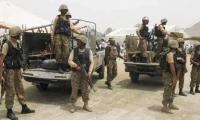With the recent rise in tensions between the two South Asian neighbours, a familiar orchestra of war hysteria has gripped the region.
Pakistan is again expressing its familiar position at world forums concerning Kashmir’s disputed status and violence in Jammu, and India is habitually threatening Pakistan in response to the attack on Uri for which India has blamed Islamabad. This state of affairs has once again pushed the two nuclear neighbours towards a hostile direction.
The proven strategic nuclear capabilities in both nations’ arsenals in the 1990s, has led to a new environment for conflict due to the stability-instability paradox. Under this paradox, direct conventional conflict is believed to have been reduced significantly, hence the stability whereas low-intensity or indirect conflict is thought to have increased instability.
This is evident due to the fact that both India and Pakistan have not fought a major conventional war since both states developed nuclear capabilities. Low-intensity direct and indirect conflicts between both countries have increased as is seen in Afghanistan, Balochistan, and Kashmir.
India’s military was postured around a non-proactive, defensive doctrine where holding corps was to deny any enemy intrusion. However, with the 1962 Sino-Indian conflict and 1965 Pakistan-India war, the doctrine further developed under the Sundarji Doctrine in 1982 where strike corps were incorporated to mobilise from central India to counter any attack on the western border, and to penetrate into Pakistani territory.
However, with the development of strategic nuclear weapons and the pitfalls of the 2001-02 standoff, India further modified its military doctrine into the pro-active Cold Start. Under this doctrine, strike corps are to be rapidly mobilised to penetrate deep into Pakistan territory with support from its combined arms operations before Pakistan has a chance to mobilise its defences.
Under the cold start regimen, India believes that it can conduct limited conventional warfare to ‘punish’ Pakistan without crossing Pakistan’s nuclear threshold or before pressure from the international community to reach a ceasefire. Although India’s doctrine may not be necessarily operational yet, with ambitions to achieve regional hegemony, India believes that with expansion and modernisations to its armed forces within the coming decades it can translate this proactive theory into practice and tilt the balance of power in its favour by establishing limited space for conflict where it can achieve superiority and allow for achieving its grander strategic goals in the region.
After the 1971 Pakistan-India war, and the separation of East Pakistan, Pakistan started perceiving India as a significant external threat. After India successfully tested its first nuclear device codenamed ‘Smiling Buddha’ in 1974, Pakistan immediately focused its resources to acquire strategic nuclear capabilities for deterrence against future Indian aggression. And with nuclear tests by both India and Pakistan in 1998, a new environment for conflict emerged. Despite both nations now harbouring nuclear shields as a deterrent, low-intensity conflict was on the rise, hence leading to India’s development of the Cold Start doctrine. To counter this new assertive India, Pakistan has developed tactical nuclear weapons similar to Nato’s response to the Warsaw Pact in West Germany during the Cold War, and has signaled the possible use of tactical nuclear weapons (TNWs) in conventional battlefield theater operations in an event of foreign aggression. India’s strategy to penetrate deep into Pakistani territory up to the Sutlej and Ravi rivers was similar to Soviet grand battle strategy intended to push Nato forces to the river Rhine in West Germany through a mass assault.
The introduction of TNWs and Pakistan’s development of various delivery systems has allowed it to credibly deter aggression from India at the conventional level by guaranteeing Mutually Assured Destruction (MAD). This is due to real risk of rapid escalation created by an environment, where nuclear thresholds may diminish significantly after the first use of TNWs in battlefield operations. Furthermore, Pakistan’s nuclear threshold is ambiguous, much like Nato’s policy on TNWs deployment during the Cold War, thus making Indian military planners more cautious. Both nations are also in the process of developing second strike capability or may already posses it. Therefore, mutually assured destruction remains relevant to the balance of power in South Asia to this day.
Given these new dynamics in today’s security environment, both nations particularly India need to realise the severe consequences of realising these strategies. Even low intensity conflicts under nuclear overhang can escalate beyond the limited theater of control and create a ‘use it or lose it’ dilemma ultimately leading to use of nuclear weapons.
In addition, movement towards hostilities between the two neighbours risks creating instability and further polarisation in one of the least economically integrated region of the world. Furthermore, with the very real threat of transnational movements such as ISIS that thrive in unstable environments, both nations need to realise many common threats they face in the region. Pakistan has realised the threats posed by such transnational movements with the development of its ‘Threat Matrix’ which saw a paradigm shift in Pakistani national security thinking and the subsequent campaign along the Afghan border in 2014.
Neither Pakistan nor India can afford to be in this perpetual state of hostility. With India’s government revisiting the World Bank brokered Indus Treaty and withdrawing from the Saarc summit, the region is already heading towards a more unstable and unpredictable zone. Dialogue and engagement between both parties to find common ground to resolve their disputes is the only positive way forward. Even without immediate results, a sustained dialogue can help governments on both sides, manage public perceptions and lower emotions and war mongering.
In parallel with a sustained dialogue, both sides need to engage in measures for confidence building. In the military realm, the CBMs should encompass steps for a risk reduction and avoidance of arms race. Both sides should seriously consider a dialogue on mutual threat perceptions and military doctrines. Offensive doctrines like Cold Start should be eschewed and replaced with defensive doctrines and force postures. This will diminish the rationale for the other side for conventional and/or nuclear build ups and pave the way for strategic restraints, nuclear and missile, in South Asia. It will create a conductive environment for the sustainability of the dialogue for resolving long-standing disputes between the two neighbours faced by common challenges such as poverty, climate change, and food security. The sooner decades old disputes are resolved, the sooner both nations can secure a brighter future for the region.
The writer is a student of McGill University
Email: Daniyal.J.Iqal@gmail.com
Hunt of non-exportable markhor took place in Rambur valley in Lower Chitral
Sindh ACE formally implicated Murtaza Jatoi in case of occupying state property in Moro, Naushero Feroze
KP CM took a jab at Punjab government, mocking poor durability of a public project
Promo highlights powerful performances of Mehwish Hayat, Ahsan Khan, and Hira Mani
Over million deserving families will benefit from package without any discrimination in transparent manner







